Prince Harry walks through Angola minefield 22 years after Diana
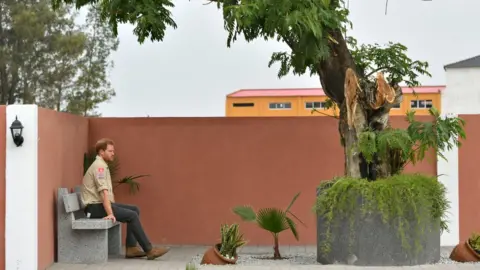 Reuters
ReutersThe Duke of Sussex has visited the former minefield in Angola where his mother Diana, Princess of Wales, walked 22 years ago, shortly before she died.
Prince Harry visited the site in Huambo, which has become a "bustling community" since Diana's campaign.
Wearing body armour, he also visited a partially-cleared minefield nearby and set off a controlled explosion.
Diana captured global attention when she walked through the live minefield in 1997.
She never lived to see the full impact of her visit - such as the signing of an international treaty to outlaw the weapons - as she died later that year.
Retracing his mother's footsteps in central Angola, Prince Harry is being escorted by the British landmine clearance charity the Halo Trust, which also accompanied Diana on her visit.
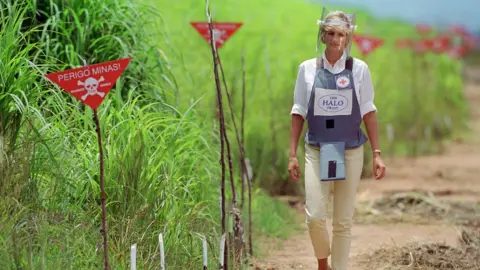 Getty Images
Getty Images Reuters
ReutersAfter walking along the suburban street, which was once filled with the explosives, the duke said it was "quite emotional" to retrace Diana's steps "and to see the transformation that has taken place, from an unsafe and desolate place into a vibrant community of local businesses and colleges".
He added: "Without question if she hadn't campaigned the way that she did, this arguably could still be a minefield.
"I'm incredibly proud of what she's been able to do, and meet these kids here who were born on this street."
The area has become a "completely different place" since demining and now is a "bustling community" with houses and schools and shops, added Camille Wallen, director of strategy at the Halo Trust.
'Scar of war'
Earlier, Prince Harry visited a minefield near the south-eastern town of Dirico, which is in the process of being cleared.
The site was mined by anti-government forces in 2000 when they retreated from their base.
In 2005, a 13-year-old girl lost a foot after stepping on one of the explosive devices in the area.
Halo Trust staff have been working to make the minefield safe since August and hope to clear it by the end of October.
Prince Harry was given a safety briefing and told not to stray off the cleared lanes, not to touch anything or run.
In a speech, the duke said the Halo Trust was helping the community "find peace".
"Landmines are an unhealed scar of war. By clearing the landmines we can help this community find peace, and with peace comes opportunity," he said.
"Additionally, we can protect the diverse and unique wildlife that relies on the beautiful Kuito river that I slept beside last night."
The prince called for an international effort to clear landmines from the Okavango watershed in the Angolan highlands, where the weapons remain 17 years after the end of a civil war.
The conflict - between 1975 and 2002 - has left Angola one of the most mined places in the world, with around 1,200 minefields, according to the Halo Trust.
The organisation says it has decommissioned almost 100,000 mines since 1994 but it is impossible to know exactly how many remain.
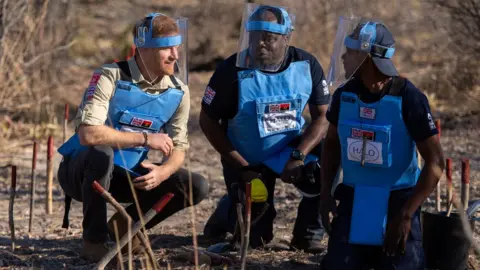 Reuters
ReutersThere are two main types of mine: anti-personnel landmines, aimed at killing or injuring people, and anti-tank mines, designed to destroy vehicles.
The random placement of the explosive devices became part of military strategy in the 1960s.
Around 50 years later, about 60 countries and territories are still contaminated with anti-personnel mines.
More than 120,000 people were killed or injured by landmines between 1999-2017, according to research by Landmine Monitor.
Civilians made up 87% of casualties, while nearly half of the victims were children.
Ms Wallen described Prince Harry's visit as a "really significant moment".
"As we saw in 1997, Princess Diana really helped raise awareness of the issue of landmines and the plight that people who live with landmines have every day," she told BBC Breakfast.
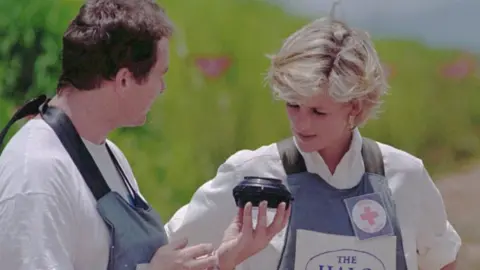 EPA
EPA"It effectively transformed what we do, and it transformed it for those people. They really felt they were being heard."
Princess Diana's involvement in the cause involved a call for a global ban on landmines.
Three months after her death in 1997, 122 countries signed the Ottawa Treaty, which prohibits the use, production, stockpiling and transfer of anti-personnel mines.
Ms Wallen said Prince Harry's visit helped "remind the world that landmines are not just a thing of the past".
"Decades after conflict they continue to threaten people's lives," she added.
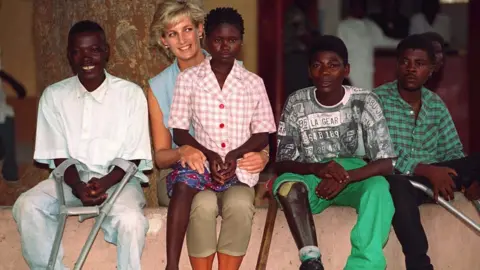 Getty Images
Getty ImagesAngolan minister Lucio Goncalves Amaral said Diana's anti-mine campaign left a "humanistic heritage" that motivated the country's authorities to push to remove all the devices from the country by 2025.
"We will never forget her priceless contribution to the campaign to ban the anti-personnel landmines," Angola's deputy minister for social integration said in a speech.
"The Angolan people will be eternally grateful for her performance in the demining process of our territory."
Prince Harry, who is on a tour of southern Africa, visited Botswana on Thursday, where he helped plant trees.
The duke said there was a race against time to stop global warming, adding he was "troubled" by climate-change deniers.
On Wednesday, Prince Harry visited South Africa, where he and the Duchess of Sussex introduced their baby son to the veteran anti-apartheid campaigner, Archbishop Desmond Tutu.
The couple also met faith leaders at South Africa's first and oldest mosque and visited a mental health charity.
The duchess told teenage girls in a deprived part of the country she was visiting South Africa not only as a member of the Royal Family, but also "as a woman of colour and as your sister".
On Friday, Buckingham Palace confirmed the duchess had paid a private visit to the memorial of a murdered South African student "after closely following the tragic story".
Meghan made the "personal gesture" at the post office where 19-year-old University of Cape Town student Uyinene Mrwetyana was raped and murdered last month.
A spokeswoman for Buckingham Palace said: "Having closely followed the tragic story, it was a personal gesture she wanted to make."
A 42-year-old male post office worker has been arrested over the killing.
